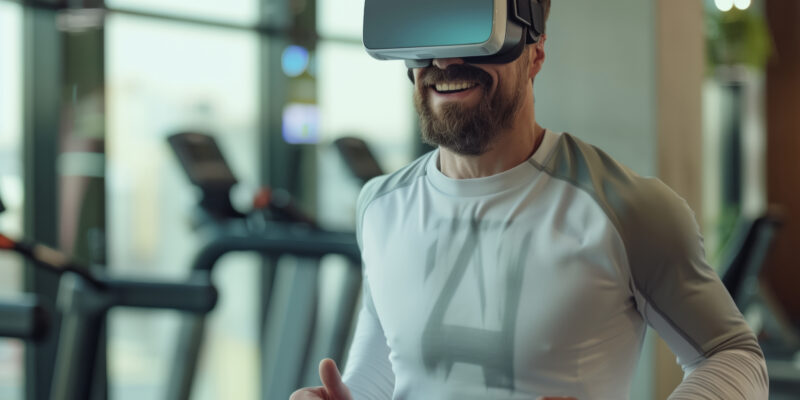
In recent years, the fitness industry across the Middle East and North Africa (MENA) has been undergoing a significant transformation, spurred by advancements in technology. Virtual Reality (VR) and Artificial Intelligence (AI) are at the forefront of this revolution, providing innovative solutions that enhance how individuals in the region approach health and fitness. This article explores the impactful integration of VR and AI into the MENA fitness industry, detailing how these technologies are not only changing the landscape but also setting new standards for personal fitness.
The Technological Revolution in Fitness
The global fitness industry has long been a beneficiary of technological advancements, but only recently have VR and AI begun to significantly influence fitness methodologies. In the MENA region, where tech adoption rates are rapidly increasing, these technologies offer exciting possibilities for personalized, efficient, and engaging fitness experiences.
The Role of Virtual Reality in Fitness
Immersive Workout Environments: VR technology in fitness provides immersive environments that can motivate users by transporting them to virtual locations far beyond the walls of their local gym. For instance, a user in Dubai can experience cycling through the Alps or practice yoga on a serene beach in the Maldives, all from a VR-equipped fitness studio.
Enhanced Engagement and Retention: One of the biggest challenges in fitness is keeping participants motivated. VR makes workouts more engaging and fun, which can significantly improve retention rates. Gamification of fitness routines, where users can earn points or reach new levels, adds an element of competition and achievement to regular workouts.
Accessibility and Safety: VR also allows individuals who may be intimidated by traditional gym environments or those with physical limitations to engage in physical activity in a controlled and safe virtual space. This inclusivity broadens the market for gyms and fitness centers by catering to a more diverse clientele.
The Impact of Artificial Intelligence on Fitness
Personalized Training Programs: AI is revolutionizing personal training by using data to customize workout plans to an individual’s specific needs and progress. Algorithms analyze performance metrics from past workouts to optimize future sessions, adjusting for intensity, duration, and type of exercise to maximize results and minimize the risk of injury.
AI-Powered Fitness Apps and Wearables: In the MENA region, the proliferation of fitness apps and wearable devices integrated with AI allows users to track their health metrics in real-time. These devices can monitor heart rate, calorie expenditure, sleep patterns, and even provide recommendations for nutritional intake.
Predictive Health Analytics: AI’s capability extends to predicting potential health issues based on workout data combined with other health indicators. This predictive analysis can be crucial in preventing injuries and managing chronic conditions, making fitness routines safer and more effective.
Integrating VR and AI into MENA Fitness Businesses
Fitness centers and gyms in the MENA region can leverage VR and AI to differentiate themselves from competitors and attract a tech-savvy clientele. Offering VR-based fitness classes or AI-powered personal training services can enhance the value provided to customers, justifying premium pricing and improving customer loyalty.
Challenges and Considerations
While the potential of VR and AI in fitness is immense, there are challenges to widespread adoption:
High Initial Investment: The cost of VR equipment and the development of AI software can be substantial. Fitness businesses need to carefully consider the ROI and possibly seek partnerships or external funding to cover these costs.
Privacy Concerns: With AI collecting vast amounts of personal data, privacy concerns are paramount. Fitness businesses must ensure they have robust data protection measures in place to safeguard user information.
Technological Adaptation: There is a learning curve associated with using advanced technologies like VR and AI. Both clients and staff may require training to effectively use these technologies, necessitating ongoing education and support.
The Future Landscape
As technology continues to evolve, the future of fitness in the MENA region looks increasingly digital. VR and AI are not merely passing trends but foundational technologies reshaping the fitness industry. As more fitness businesses adopt these technologies, they will set new standards for what consumers expect from a fitness experience, driving further innovations and improvements across the industry.
Conclusion
The integration of VR and AI technologies is transforming the fitness industry in the MENA region, making workouts more personalized, engaging, and effective. For fitness businesses, staying abreast of these technological developments is no longer optional but a necessity to remain competitive and relevant in a rapidly evolving market. As these technologies continue to develop, they promise to unlock even more innovative ways to meet the health and fitness needs of the population, ensuring that the fitness industry remains at the cutting edge of both technology and wellness.














